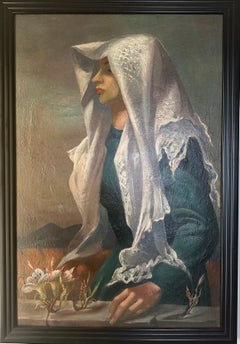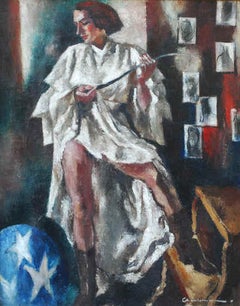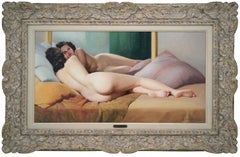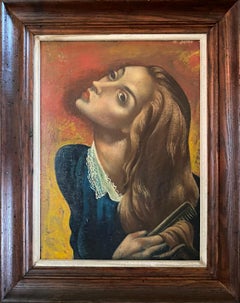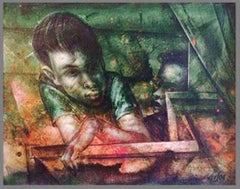Michael Lenson Paintings
American, 1903-1971
Michael Lenson was born in Russia in 1903. He is a Russian-American painter who won a prize at the National Academy of Design and exhibited at several New York galleries, before becoming the director of WPA mural projects in New Jersey in the 1930s. Lenson painted a set of murals on the history of Newark for City Hall, including scenes showing industries such as tanning and iron casting.
to
1
Overall Width
to
Overall Height
to
1
1
1
1
1
1
1
1
1
1
1
1
1
781
718
706
692
1
1
Artist: Michael Lenson
White Shawl
By Michael Lenson
Located in Los Angeles, CA
Michael Lenson
1903-1971
"WHITE SHAWL"
OIL ON PANEL, SIGNED
AMERICAN, C.1935
30 X 20 INCHES
Category
1930s Art Deco Michael Lenson Paintings
Materials
Canvas, Oil
Related Items
Femme du Cirque
By Paul Charlemagne
Located in West Hollywood, CA
Presenting an original oil by French artist Paul Charlemagne, “Femme du Cirque”, an original oil on canvas, signed, c.1930, with an image dimension of 30 x 24 inches.
Category
1920s Art Deco Michael Lenson Paintings
Materials
Canvas, Oil
Oil on canvas, Naked woman lying in front of her mirror
By Robert Louis Raymond Duflos
Located in Saint Amans des cots, FR
Oil on canvas by Robert Louis Raymond DUFLOS (1898-1929), France, 1920s. Naked woman lying in front of her mirror. With frame: 95x61.5 cm -...
Category
1920s Art Deco Michael Lenson Paintings
Materials
Canvas, Oil
$7,900
H 24.22 in W 37.41 in D 2.76 in
YVES DIEY The Nude, Oil on canvas, 1930s
By Yves Diey
Located in Saint Amans des cots, FR
Oil on canvas by Yves Dieÿ (1892-1984), France – The Nude. A striking oil on canvas by the renowned French artist Yves Dieÿ (1892-1984), depicting a sensual and elegant nude. This wo...
Category
1930s Art Deco Michael Lenson Paintings
Materials
Canvas, Oil
A Liberated Lady On The Cliffs Nude Sunbathing Framed 1920s French Oil Painting
Located in Sutton Poyntz, Dorset
Raymond Moritz.
French ( b.1891 - d.1950 ).
A Liberated Lady On The Cliffs, 1927.
Oil On Canvas.
Signed Lower Left.
Image size 25 inches x 20.7 inches ( 63.5cm x 52.5cm ).
Frame size 29.3 inches x 24.8 inches ( 74.5cm x 63cm ).
Available for sale; this original oil painting is by the French artist Raymond Moritz and dates from 1927.
The painting is presented and supplied in a sympathetic contemporary frame (which is shown in these photographs), mounted with new fixtures.
The canvas and the painted surface have benefitted from cleaning and conservation, which was performed on our instruction, supervision and approval.
This vintage painting is now in very good condition. It wants for nothing and is supplied ready to hang and display.
The painting is signed lower left.
A later dedication to “Louise” dated April 1942 in the artist’s hand is set around the earlier signing.
Raymond Moritz was a French impressionist artist and illustrator. He was born in Paris on 8 July 1891. His family came from the Alsace region and were poor and Catholic. On his mother’s side, the Staubs were from Wihr-au-Val where they had been coopers for several generations. His uncle, Marie Clement Staub, was the founder in Canada of the Sisters of Saint Joan of Arc.
Moritz fought during the Great War in the Picardy region of the Somme with the 2nd machine gunner company. He won the French 1914-1918 War medal with bronze palm attachment, which signifies that the awardee was mentioned in dispatches at army level. Moritz obviously created some art during the war because during the inauguration of the new town hall in the town of Albert he was congratulated by the French President, Albert Lebrun, and the British press for the paintings he had produced. Albert was the main town behind the lines for the Allies on the Somme battle fields...
Category
Early 20th Century Art Deco Michael Lenson Paintings
Materials
Oil, Canvas
$10,597
H 29.34 in W 24.81 in D 1.78 in
R.B. FELTRAP, Oil on canvas, Nude, 1937
Located in Saint Amans des cots, FR
Oil on canvas signed R.B.FELTRAP, France, 1937. Nude. With frame : 101.5x82.5 cm - 40x32.5 inches ; without frame : 92x73 cm - 36.2x28.75 inches. Format 30F. Signed and dated "R.B.Fe...
Category
1930s Art Deco Michael Lenson Paintings
Materials
Canvas, Oil
TARKAY, ITZCHAK "LAKE CAFE" 2000, ORIGINAL ACRYLIC ON CANVAS 36X48
By Itzchak Tarkay
Located in Pembroke Pines, FL
Artist: TARKAY, ITZCHAK
Title: LAKE CAFE
Year: 2000-2010
Size: 36 X 48 INCHES
Medium: ORIGINAL ACRYLIC ON CANVAS
Edition: ORIGINAL 1/1
Description: Hand signed by the artist.
The art...
Category
Early 2000s Art Deco Michael Lenson Paintings
Materials
Canvas, Acrylic
$14,900
H 36 in W 48 in D 2 in
Art Deco male athlete harlequin with guitar by deaf artist cubist painting
Located in Norwich, GB
A stunning oil on canvas in the purest art deco style by French born Jean Hanau. It depicts a harlequin-in a tight chequered body suit. Athletically built, ...
Category
Early 20th Century Art Deco Michael Lenson Paintings
Materials
Oil, Canvas
$2,800
H 27.17 in W 23.63 in D 1.58 in
Regattas day (a tribute to Seurat). Large format Riverside scene with figures.
By Fabio Hurtado
Located in Segovia, ES
Reggatas day (tribute to Seurat), by Fabio Hurtado, is an oil painting on canvas which was created in 1995 and which obtained the Honorary Medal at the C...
Category
1990s Art Deco Michael Lenson Paintings
Materials
Canvas, Oil
$68,761
H 44.89 in W 76.78 in D 0.79 in
Les Amies
By Micao Kono
Located in West Hollywood, CA
Micao Kono was born in Japan, moving to work in Paris in the 1920's. His style, a mixture of Japanese watercolor and figurative Art Deco. He often mixed egg tempera into his oils to ...
Category
1920s Art Deco Michael Lenson Paintings
Materials
Canvas, Oil
Hortense (Ballerina) /// Impressionism Degas French Ballet Renoir Figurative Art
By Pal Fried
Located in Saint Augustine, FL
Artist: Pál Fried (Hungarian, 1893-1976)
Title: "Hortense (Ballerina)"
*Signed by Fried lower left
Circa: 1940
Medium: Original Oil Painting on Canvas
Framing: Framed in a light gold...
Category
1940s Art Deco Michael Lenson Paintings
Materials
Canvas, Paint, Oil
$4,250 Sale Price
29% Off
H 36.88 in W 30.88 in
“Maiden by a Stream”
Located in Southampton, NY
Original oil painting on canvas of a young maiden sitting near a dramatic stream with large rock out croppings. Attributed to the hand of Allen Townsend Terrell. Signed “Terrell” v...
Category
1930s Art Deco Michael Lenson Paintings
Materials
Canvas, Oil
Carnival in Munich
Located in Miami, FL
Ferdinand Leeke
Carnival test, 1914
Oil on canvas
32 x 39 in
Category
1910s Art Deco Michael Lenson Paintings
Materials
Canvas, Oil
Previously Available Items
Combing
By Michael Lenson
Located in Los Angeles, CA
Early work by American artist Michael Lenson.
Category
1950s Art Deco Michael Lenson Paintings
Materials
Oil, Panel
Under Stairs
By Michael Lenson
Located in Los Angeles, CA
MICHAEL LENSON
"UNDER THE STAIRS"
ACRYLIC ON CANVAS, SIGNED
AMERICAN, C.1960
16 X 20 INCHES
Michael Lenson
1903-1971
Michael Lenson was born in Galich, a Russian city of 25,000 situated on the eastern slopes of the Ural Mountains. “In winter, peasants from the north packed their horse-drawn sleighs with kindling and drove into the town across frozen Lake Galich,” Lenson later recalled. “Haggard monks paraded through the town carrying icons, then banged on our door to solicit alms. Wolves roamed through the streets in the dead of winter, and the Tsar and his family stopped their private railway car at the Galich station every summer to receive gifts of locally made leather boots from the local town officials.”
Although Lenson and his family emigrated to New York when he was only seven years old, those vivid childhood memories stayed with him, and may have sparked the dream-infused imagery in his paintings and drawings.
By 1928, Lenson was a struggling art student sharing a coldwater flat on East 116th Street in New York City flat with fellow artists Louis Guglielmi (1906-1956) and Gregorio Prestopino (1907-1984). He studied at the National Academy of Design and sketched at the Metropolitan Museum. To keep meat on his bones, Lenson was working in the Post Office at night, and airbrushing shoes for mail-order catalogs during the day. But that year, Lenson’s life changed dramatically when he was awarded the much-coveted $10,000 Chaloner Prize for Painting.
“It was fantastic, absolutely fantastic,” Lenson later told an interviewer for the Smithsonian’s Oral History Project. “All of a sudden my worries fell away and I was aboard ship. All my relatives who considered me a no-good deficit to the family were on the dock waving farewell to me.”
Thus the Russian born artist was able to return to Europe for four years of travel and study. At the University of London’s Slade School of Art, Lenson logged long months sitting at a drafting table, mastering the drawing skills that would remain a hallmark of his work. “You could say that the instruction there was academic,” he later recalled, “but boy, did they know their stuff.” While in London, Lenson also assisted the noted muralist Colin Gill.
Moving on to Paris, Lenson occupied a Chaloner-funded apartment near the Jardin de Luxembourg. He enrolled in the Académie des Beaux-Arts, and began to paint large figurative canvases that were strongly influenced by the old master works that he studied at the Louvre. Beyond studying, Lenson made the most of his years in Paris. He and a circle of American expatriates congregated at Le Dôme Café in the evenings for camaraderie and drinks. He heard Chaliapin sing and saw Ravel conduct. He escorted glamorous women, including Henrietta Schumann, the phenomenal young Russian-American concert pianist who had just arrived in Paris to study with Alfred Cortot...
Category
1960s Modern Michael Lenson Paintings
Materials
Canvas, Oil
TERRIBLE WITH BANNERS"
By Michael Lenson
Located in Los Angeles, CA
MICHAEL LENSON
"TERRIBLE WITH BANNERS"
OIL ON MASONITE, SIGNED, TITLED
AMERICAN, C.1959
42 X 28.5 INCHES
Michael Lenson
1903-1971
Michael Lenson was born in Galich, a Russian city of 25,000 situated on the eastern slopes of the Ural Mountains. “In winter, peasants from the north packed their horse-drawn sleighs with kindling and drove into the town across frozen Lake Galich,” Lenson later recalled. “Haggard monks paraded through the town carrying icons, then banged on our door to solicit alms. Wolves roamed through the streets in the dead of winter, and the Tsar and his family stopped their private railway car at the Galich station every summer to receive gifts of locally made leather boots from the local town officials.”
Although Lenson and his family emigrated to New York when he was only seven years old, those vivid childhood memories stayed with him, and may have sparked the dream-infused imagery in his paintings and drawings.
By 1928, Lenson was a struggling art student sharing a coldwater flat on East 116th Street in New York City flat with fellow artists Louis Guglielmi (1906-1956) and Gregorio Prestopino (1907-1984). He studied at the National Academy of Design and sketched at the Metropolitan Museum. To keep meat on his bones, Lenson was working in the Post Office at night, and airbrushing shoes for mail-order catalogs during the day. But that year, Lenson’s life changed dramatically when he was awarded the much-coveted $10,000 Chaloner Prize for Painting.
“It was fantastic, absolutely fantastic,” Lenson later told an interviewer for the Smithsonian’s Oral History Project. “All of a sudden my worries fell away and I was aboard ship. All my relatives who considered me a no-good deficit to the family were on the dock waving farewell to me.”
Thus the Russian born artist was able to return to Europe for four years of travel and study. At the University of London’s Slade School of Art, Lenson logged long months sitting at a drafting table, mastering the drawing skills that would remain a hallmark of his work. “You could say that the instruction there was academic,” he later recalled, “but boy, did they know their stuff.” While in London, Lenson also assisted the noted muralist Colin Gill.
Moving on to Paris, Lenson occupied a Chaloner-funded apartment near the Jardin de Luxembourg. He enrolled in the Académie des Beaux-Arts, and began to paint large figurative canvases that were strongly influenced by the old master works that he studied at the Louvre. Beyond studying, Lenson made the most of his years in Paris. He and a circle of American expatriates congregated at Le Dôme Café in the evenings for camaraderie and drinks. He heard Chaliapin sing and saw Ravel conduct. He escorted glamorous women, including Henrietta Schumann, the phenomenal young Russian-American concert pianist who had just arrived in Paris to study with Alfred Cortot.
Lenson later said that when he returned to New York in 1932, “I was no longer the conquering hero. I came back to nothing . . . absolutely nothing.”
Although the Great Depression was dawning, Lenson’s first one-man exhibition at the Caz-Delbo Gallery was a notable success. In a review in the April 30, 1933 New York Times, distinguished critic Howard Devree wrote:
“He stands at the beginning of a very promising career, without close allegiance to any of the great names or schools. Yet in the best sense of the word he is traditional . . . The best of his things strike a good working balance between [color and form]. His figure studies . . . show him at his best . . . His still life is restrained both in color and form - refinement without academicism. The portraits show a sympathy with the old masters of the French school and yet are thoroughly modern. His landscapes are well worked out and lighted. His later things give evidence of growing freedom in the use of clear, rich color and of gathering powers of simplification.”
Margaret Breuning, another noted critic, said of Lenson’s work in her review in the New York Evening Post on May 1, 1933:
“He is a young artist who works in the tradition, particularly in his excellent portraits, but is finding a growing power to enrich tradition with personal expression . . . All the work has an integrity and soundness which warrant a belief in the artist’s future performance.”
Such interviews did not feed artists in those bleak Depression days. Before long, Lenson found his way to New Jersey, where he joined the Federal Arts Project and quickly secured a mural commission for an immense wall in a tuberculosis hospital in Verona, New Jersey and soon painted murals for the New Jersey Pavilion of the 1939 World’s Fair. By then, Lenson had been appointed supervisor for all WPA mural projects in the State. Other mural commissions followed, including his eight-panel “History of Newark” in the City Council Chambers at Newark City Hall and his “Enlightenment of Man” panoramic mural in Weequahic High School in Newark. Another extant Lenson mural is “Mining,” completed for the U.S. Post Office in Mount Hope, West Virginia. Who Was Who In American Art? calls Lenson, “New Jersey’s most important muralist.” Recently, Lenson’s remarkable contributions to WPA art were covered extensively by Nick Taylor in his book, American Made: The Enduring Legacy of the WPA.
After the demise of the WPA, Lenson bought a studio home in Nutley, a town seven miles north of Newark. He married June Rollar, an aspiring poet, and had two sons. Later, he taught painting at Rutgers University and the Montclair Art Museum. During the last sixteen years of his life, Lenson served as art critic for The Newark Sunday News.
Michael Lenson’s paintings are in numerous private collections and in the permanent collections of many institutions, including the Johnson Museum at Cornell University, the Princeton University Art Museum, the Maier Museum of American Art, and the Quick Center for the Arts at Saint Bonaventure...
Category
1950s Surrealist Michael Lenson Paintings
Materials
Masonite, Oil
Under the Stairs
By Michael Lenson
Located in Los Angeles, CA
MICHAEL LENSON
"UNDER THE STAIRS"
ACRYLIC ON CANVAS, SIGNED
AMERICAN, C.1960
16 X 20 INCHES
Michael Lenson
1903-1971
Michael Lenson was born in Galich, a Russian city of 25,000 situated on the eastern slopes of the Ural Mountains. “In winter, peasants from the north packed their horse-drawn sleighs with kindling and drove into the town across frozen Lake Galich,” Lenson later recalled. “Haggard monks paraded through the town carrying icons, then banged on our door to solicit alms. Wolves roamed through the streets in the dead of winter, and the Tsar and his family stopped their private railway car at the Galich station every summer to receive gifts of locally made leather boots from the local town officials.”
Although Lenson and his family emigrated to New York when he was only seven years old, those vivid childhood memories stayed with him, and may have sparked the dream-infused imagery in his paintings and drawings.
By 1928, Lenson was a struggling art student sharing a coldwater flat on East 116th Street in New York City flat with fellow artists Louis Guglielmi (1906-1956) and Gregorio Prestopino (1907-1984). He studied at the National Academy of Design and sketched at the Metropolitan Museum. To keep meat on his bones, Lenson was working in the Post Office at night, and airbrushing shoes for mail-order catalogs during the day. But that year, Lenson’s life changed dramatically when he was awarded the much-coveted $10,000 Chaloner Prize for Painting.
“It was fantastic, absolutely fantastic,” Lenson later told an interviewer for the Smithsonian’s Oral History Project. “All of a sudden my worries fell away and I was aboard ship. All my relatives who considered me a no-good deficit to the family were on the dock waving farewell to me.”
Thus the Russian born artist was able to return to Europe for four years of travel and study. At the University of London’s Slade School of Art, Lenson logged long months sitting at a drafting table, mastering the drawing skills that would remain a hallmark of his work. “You could say that the instruction there was academic,” he later recalled, “but boy, did they know their stuff.” While in London, Lenson also assisted the noted muralist Colin Gill...
Category
1960s American Modern Michael Lenson Paintings
Materials
Canvas, Acrylic
Under the Stairs
By Michael Lenson
Located in Los Angeles, CA
MICHAEL LENSON
"UNDER THE STAIRS"
ACRYLIC ON CANVAS, SIGNED
AMERICAN, C.1960
16 X 20 INCHES
Michael Lenson
1903-1971
Michael Lenson was born in Galich, a Russian city of 25,000 situated on the eastern slopes of the Ural Mountains. “In winter, peasants from the north packed their horse-drawn sleighs with kindling and drove into the town across frozen Lake Galich,” Lenson later recalled. “Haggard monks paraded through the town carrying icons, then banged on our door to solicit alms. Wolves roamed through the streets in the dead of winter, and the Tsar and his family stopped their private railway car at the Galich station every summer to receive gifts of locally made leather boots from the local town officials.”
Although Lenson and his family emigrated to New York when he was only seven years old, those vivid childhood memories stayed with him, and may have sparked the dream-infused imagery in his paintings and drawings.
By 1928, Lenson was a struggling art student sharing a coldwater flat on East 116th Street in New York City flat with fellow artists Louis Guglielmi (1906-1956) and Gregorio Prestopino (1907-1984). He studied at the National Academy of Design and sketched at the Metropolitan Museum. To keep meat on his bones, Lenson was working in the Post Office at night, and airbrushing shoes for mail-order catalogs during the day. But that year, Lenson’s life changed dramatically when he was awarded the much-coveted $10,000 Chaloner Prize for Painting.
“It was fantastic, absolutely fantastic,” Lenson later told an interviewer for the Smithsonian’s Oral History Project. “All of a sudden my worries fell away and I was aboard ship. All my relatives who considered me a no-good deficit to the family were on the dock waving farewell to me.”
Thus the Russian born artist was able to return to Europe for four years of travel and study. At the University of London’s Slade School of Art, Lenson logged long months sitting at a drafting table, mastering the drawing skills that would remain a hallmark of his work. “You could say that the instruction there was academic,” he later recalled, “but boy, did they know their stuff.” While in London, Lenson also assisted the noted muralist Colin Gill...
Category
1950s American Modern Michael Lenson Paintings
Materials
Acrylic, Canvas
Portrait of a Woman
By Michael Lenson
Located in Los Angeles, CA
MICHAEL LENSON
"PORTRAIT OF WOMAN"
OIL ON CANVAS, SIGNED
AMERICAN, DATED 1942
30 X 23 INCHES
Michael Lenson
Michael Lenson was born in 1903 in Galich, Russia. He em...
Category
1940s American Realist Michael Lenson Paintings
Girl with Guitar
By Michael Lenson
Located in Los Angeles, CA
MICHAEL LENSON
"GIRL WITH GUITAR"
PASTEL, SIGNED
AMERICAN, C.1935
22 X 18 INCHES
Michael Lenson
1903-1971
Michael Lenson was born in Galich, a Russian city of 25,000 situated on the eastern slopes of the Ural Mountains. “In winter, peasants from the north packed their horse-drawn sleighs with kindling and drove into the town across frozen Lake Galich,” Lenson later recalled. “Haggard monks paraded through the town carrying icons, then banged on our door to solicit alms. Wolves roamed through the streets in the dead of winter, and the Tsar and his family stopped their private railway car at the Galich station every summer to receive gifts of locally made leather boots from the local town officials.”
Although Lenson and his family emigrated to New York when he was only seven years old, those vivid childhood memories stayed with him, and may have sparked the dream-infused imagery in his paintings and drawings.
By 1928, Lenson was a struggling art student sharing a coldwater flat on East 116th Street in New York City flat with fellow artists Louis Guglielmi (1906-1956) and Gregorio Prestopino (1907-1984). He studied at the National Academy of Design and sketched at the Metropolitan Museum. To keep meat on his bones, Lenson was working in the Post Office at night, and airbrushing shoes for mail-order catalogs during the day. But that year, Lenson’s life changed dramatically when he was awarded the much-coveted $10,000 Chaloner Prize for Painting.
“It was fantastic, absolutely fantastic,” Lenson later told an interviewer for the Smithsonian’s Oral History Project. “All of a sudden my worries fell away and I was aboard ship. All my relatives who considered me a no-good deficit to the family were on the dock waving farewell to me.”
Thus the Russian born artist was able to return to Europe for four years of travel and study. At the University of London’s Slade School of Art, Lenson logged long months sitting at a drafting table, mastering the drawing skills that would remain a hallmark of his work. “You could say that the instruction there was academic,” he later recalled, “but boy, did they know their stuff.” While in London, Lenson also assisted the noted muralist Colin Gill.
Moving on to Paris, Lenson occupied a Chaloner-funded apartment near the Jardin de Luxembourg. He enrolled in the Académie des Beaux-Arts, and began to paint large figurative canvases that were strongly influenced by the old master works that he studied at the Louvre. Beyond studying, Lenson made the most of his years in Paris. He and a circle of American expatriates congregated at Le Dôme Café in the evenings for camaraderie and drinks. He heard Chaliapin sing and saw Ravel conduct. He escorted glamorous women, including Henrietta Schumann, the phenomenal young Russian-American concert pianist who had just arrived in Paris to study with Alfred Cortot.
Lenson later said that when he returned to New York in 1932, “I was no longer the conquering hero. I came back to nothing . . . absolutely nothing.”
Although the Great Depression was dawning, Lenson’s first one-man exhibition at the Caz-Delbo Gallery was a notable success. In a review in the April 30, 1933 New York Times, distinguished critic Howard Devree wrote:
“He stands at the beginning of a very promising career, without close allegiance to any of the great names or schools. Yet in the best sense of the word he is traditional . . . The best of his things strike a good working balance between [color and form]. His figure studies . . . show him at his best . . . His still life is restrained both in color and form - refinement without academicism. The portraits show a sympathy with the old masters of the French school and yet are thoroughly modern. His landscapes are well worked out and lighted. His later things give evidence of growing freedom in the use of clear, rich color and of gathering powers of simplification.”
Margaret Breuning, another noted critic, said of Lenson’s work in her review in the New York Evening Post on May 1, 1933:
“He is a young artist who works in the tradition, particularly in his excellent portraits, but is finding a growing power to enrich tradition with personal expression . . . All the work has an integrity and soundness which warrant a belief in the artist’s future performance.”
Such interviews did not feed artists in those bleak Depression days. Before long, Lenson found his way to New Jersey, where he joined the Federal Arts Project and quickly secured a mural commission for an immense wall in a tuberculosis hospital in Verona, New Jersey and soon painted murals for the New Jersey Pavilion of the 1939 World’s Fair. By then, Lenson had been appointed supervisor for all WPA mural projects in the State. Other mural commissions followed, including his eight-panel “History of Newark” in the City Council Chambers at Newark City Hall and his “Enlightenment of Man” panoramic mural in Weequahic High School in Newark. Another extant Lenson mural is “Mining,” completed for the U.S. Post Office in Mount Hope, West Virginia. Who Was Who In American Art? calls Lenson, “New Jersey’s most important muralist.” Recently, Lenson’s remarkable contributions to WPA art were covered extensively by Nick Taylor in his book, American Made: The Enduring Legacy of the WPA.
After the demise of the WPA, Lenson bought a studio home in Nutley, a town seven miles north of Newark. He married June Rollar, an aspiring poet, and had two sons. Later, he taught painting at Rutgers University and the Montclair Art Museum. During the last sixteen years of his life, Lenson served as art critic for The Newark Sunday News.
Michael Lenson’s paintings are in numerous private collections and in the permanent collections of many institutions, including the Johnson Museum at Cornell University, the Princeton University Art Museum, the Maier Museum of American Art, and the Quick Center for the Arts at Saint Bonaventure...
Category
1930s American Modern Michael Lenson Paintings
Materials
Pastel
Woman with Guitar
By Michael Lenson
Located in Los Angeles, CA
Category
1930s Michael Lenson Paintings
Materials
Oil, Canvas
SAILOR'S STORY
By Michael Lenson
Located in Los Angeles, CA
Category
Michael Lenson Paintings
Materials
Oil, Canvas
PORTRAIT OF FRANCIS HEALY
By Michael Lenson
Located in Los Angeles, CA
Category
Michael Lenson Paintings
Materials
Oil, Canvas
Kite Flyers
By Michael Lenson
Located in Los Angeles, CA
Category
Michael Lenson Paintings
Materials
Oil, Canvas
Michael Lenson paintings for sale on 1stDibs.
Find a wide variety of authentic Michael Lenson paintings available for sale on 1stDibs.
